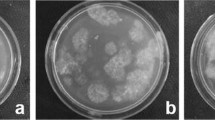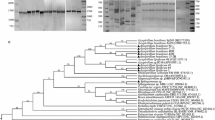Abstract
The genome of Brahyrhizobium japonicum and B. elkanii contains multiple copies of the repeated DNA sequence RSα. A collection of 18 B. japonicum, 4 B. elkanii and 72 other bacterial strains was screened by polymerase chain reaction (PCR) using a pair of primers specific for RSα. Only strains of B. japonicum and B. elkanii gave the predicted amplification product. Restriction analysis of PCR products obtained from different strains of B. japonicum showed that the RSα sequence was generally conserved. The usefulness of RSα as a specific probe for Brahyrhizobium strains capable of nodulating soybean was also demonstrated.
Similar content being viewed by others
References
Bergersen FJ (1961) The growth of Rhizobium in synthetic media. Aust J Biol Sci 14:349–360
Bromfield ESP, Wheatcroft R, Barran LR (1994) Medium for direct isolation of Rhizobium meliloti from soils. Soil Biol Biochem 26:423–428
Catroux G (1991) Inoculant quality standards and controls in France. In: Thompson JA (eds) Report on the expert consultation on legume inoculant production and quality control. FAO, Rome, pp 113–120
Date RA, Decker AM (1965) Minimal antigenic constitution of 28 strains of Rhizobium japonicum. Can J Microbiol 11:1–8
Elkan GH (1992) Taxonomy of the Rhizobia. Can J Microbiol 38:446–450
Fuhrmann J (1990) Symbiotic effectiveness of indigenous soybean Bradyrhizobia as related to serological, morphological, rhizobitoxine, and hydrogenase phenotypes. Appl Environ Microbiol 56:224–229
Grunstein M, Hogness DS (1975) Colony hybridization: a method for the isolation of cloned DNAs that contain a specific gene. Proc Natl Acad Sci USA 72:3961–3965
Hahn M, Hennecke H (1984) Localized mutagenesis in Rhizobium japonicum. Mol Gen Genet 193:46–52
Hahn M, Hennecke H (1987) Conservation of a symbiotic DNA region in soybean root nodule bacteria. Appl Environ Microbiol 53:2253–2255
Hartmann A, Catroux G, Amarger N (1992) Bradyrhizobium japonicum strain identification by RFLP analysis using the repeated sequence RS-alpha. Lett Appl Microbiol 15:15–19
Hume DJ, Blair DH (1992) Effect of numbers of Bradyrhizobium japonicum applied in commerical inoculants on soybean seed yield in Ontario. Can J Microbiol 38:588–593
Kaluza K, Hahn M, Hennecke H (1985) Repeated sequences similar to insertion elements clustered around the nif region of the Rhizobium japonicum genome. J Bacteriol 162:535–542
King EO, Ward MK, Raney DE (1954) Two simple media for the demonstration of pyocianin and fluorescein. J Lab Clin Med 44:301–307
Kuykendall LD; Saxena B, Devine TE, Udell SE (1992) Genetic diversity in Bradyrhizobium japonicum Jordan 1982 and a proposal for Bradyrhizobium elkanii sp. nov. Can J Microbiol 38:501–505
Laguerre G, Allard MR; Revoy F, Amager N (1994) Rapid identification of Rhizobia by restriction fragment length polymorphism analysis of PCR-amplified 16S rRNA genes. Appl Environ Microbiol 60:56–63
Minamisawa K, Seki T, Onodera S, Kubota M, Asami T (1992) Genetic relatedness of Bradyrhizobium japonicum field isolates as revealed by repeated sequences and various other characteristics. Appl Environ Microbiol 58:2832–2839
Neilson JW, Josephson KL, Pillai SD, Pepper IL (1992) Polymerase chain reaction and gene probe detection of the 2,4-dichlorophenoxyacetic acid degradation plasmid, pJP4. Appl Environ Microbiol 58:1271–1275
Olsen PE, Rice WA (1991) Use of monoclonal antibodies in a colony immunoblot analysis of viable Rhizobium cell numbers in legume inoculants and on preinoculated seeds. Can J Microbiol 37:430–432
Ramseier TM, Gottfert M (1991) Codon usage and G+C content in Bradyrhizobium japonicum genes are not uniform. Arch Microbiol 156:270–276
Vincent JM (1970) A manual for practical study of root nodule bacteria. In: International biological programme handbook No. 15. Blackwell Scientific Publications, Oxford, UK
Weber DF, Keyser HH, Uratsu SL (1989) Serological distribution of Bradyrhizobium japonicum from U.S. soybean production areas. Agron J 81:786–789
Wheatcroft R, Bromfield ESP, Laberge S, Barran LR (1993) Species specific DNA probe and colony hybridization of Rhizobium meliloti. In: Palacios R, Mora J, Newton WE (eds) New horizons in nitrogen fixation. Kluwer, Boston, p 661
Author information
Authors and Affiliations
Rights and permissions
About this article
Cite this article
Hartmann, A., Gomez, M., Giraud, J.J. et al. Repeated sequence RSα is diagnostic for Bradyhizobium japonicum and Bradyrhizobium elkanii . Biol Fertil Soils 23, 15–19 (1996). https://doi.org/10.1007/BF00335812
Received:
Issue Date:
DOI: https://doi.org/10.1007/BF00335812




